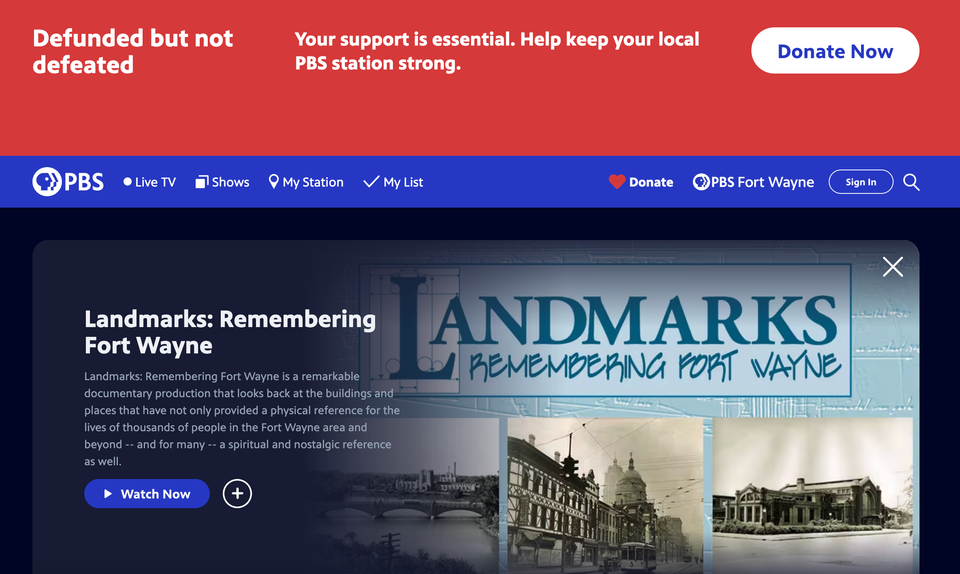How will public media cuts affect Fort Wayne’s news ecosystem – and the economy?
We break down how taxpayers foot the bill for fewer jobs and support for public media.

This year, Allen County ranked 44th out of 92 counties in Indiana for its low number of local journalists – only 8 per 100,000 residents, according to the national Local Journalist Index.
🤙
This week we're giving all subscribers access to our Thursday letter. If you're a free subscriber, become a paid member to continue getting our Thursday deep dives!
For a quick refresher...
In Tuesday’s newsletter, we previewed how:
- National lawmakers are rescinding federal funding for public media as part of more than $1 billion in cuts to the Corporation for Public Broadcasting (CPB). Debate has largely centered on perceived bias in national PBS + NPR news and programming. But…
- The funding cuts will primarily affect local affiliate stations, like PBS Fort Wayne and 89.1 WBOI. (70% of CPB funding went directly to local communities.) These stations employ local residents and produce original, hyper-local journalism and public information that underpins Fort Wayne’s media scene.
- This will affect the local media ecosystem – and the economy. Along with fewer local (creative sector) jobs, there will also be less public information available to historians and journalists who remain, straining an already sparse media landscape. And research shows that when journalism suffers in cities, the people who often foot (higher) bills for its loss are – you guessed it – local taxpayers.
How so?
We break it down in a few quick questions.
- How are PBS Fort Wayne and 89.1 WBOI affected by the funding cuts?
- By the numbers: when you combine state and federal cuts for public media (which take effect in October), PBS Fort Wayne stands to lose about 42% of its annual operating budget, and 89.1 WBOI could lose about 12% of its annual revenue for 2025.
- This means: PBS Fort Wayne is at risk of going off-air – though new President & CEO Ed Leon is optimistic the station’s loyal funders and creative problem-solving will pull through. At 89.1 WBOI, President & General Manager Travis Pope tells us his team is going to “do less, more intentionally,” including less overall local coverage. “That’s less features and less news stories, with the hope of better covering what audio storytelling allows us to cover best,” he says.
- So far: both organizations say they have reduced staff within the past year in preparation for cuts. They’re still trying to navigate the daily changes beyond finances, too, like operational services formerly performed by the CPB, ranging from negotiating with record labels for music rights to disseminating new technology. “We’re learning more about this new reality every day,” Pope says.
- So what’s the state of local journalism in Fort Wayne and beyond?
- There’s actually new data to gauge it county-by-county. In early July, researchers from the national nonprofit Rebuild Local News and the tech platform Muck Rack released a first-of-its-kind count of how many journalists remain in the U.S. Spoiler alert: the results aren’t encouraging. Across the U.S., counties have already seen an average 75% reduction in local journalists since 2002.
- Allen County ranks 44th out of 92 counties in Indiana for its low number of local journalists – with only eight journalists per 100,000 residents. So we have the third highest population in the state, but a disproportionately low number of journalists to serve our (growing) population – and that’s before new cuts to public media take effect.
- Public media (like PBS Fort Wayne and 89.1 WBOI) are important because they're filling gaps in the local media ecosystem. This includes everything from the research provided by hyper-local documentaries to the creative arts coverage of Julia Meek’s popular “Folktales” and “Meet the Music." As Pope puts it: “[Federal and state funding cuts] mean that we won’t have the resources to fill the void left by other outlets with challenging business models of their own…. I’d hoped to create a small investigative news team to tackle bigger stories in hour-long specials and podcasts in my second year here. That, I can say for certain, won’t be happening due to these cuts.”
- Okay, but why does the number of local journalists matter to the local economy? And does reducing funding for public media save taxpayers' money?
- Local journalism provides an important check on the power structures of local governments and businesses. While many taxpayers treat local news like a consumer product, it actually provides a public service more like a police station. As NPR’s “Hidden Brain” puts it: “If you decide not to buy a watch or a cappuccino, you save money. But if you decide not to pay for a police department [or a newspaper], you might save money in the short run, but end up paying more in the long run.” Fewer journalists in cities equates to less overall information, less investigative reporting, and less accountability for leaders and public officials, which tends to result in some unruly spending….
- Researchers have found a connection between the loss of local journalism (or public information) and taxpayers footing higher bills for government projects and unchecked corruption. A 2018 report on the “Impact of Newspaper Closures on Public Finance” found that “Following a newspaper closure, municipal borrowing costs increase by 5 to 11 basis points, costing the municipality an additional $650 thousand per issue.” In other words: journalism is a trusted mechanism for holding governments accountable, and that both: reduces borrowing costs for local governments trying to finance projects and helps deter government corruption and overspending.
- Plus, a healthy news ecosystem is a key component of any thriving community (and democracy). Along with the occasional high-stakes investigative work journalists do, communities generally benefit from having effective, public-funded news outlets disseminating information – which is precisely the point of public media (globally). However, in the U.S., public media has been woefully underfunded compared to other wealthy countries. Additional global research finds “high levels of secure funding for public media systems” in countries are “consistently and positively correlated with healthy democracies.” When citizens have quality, cost-free ways of engaging with local news and information, they can more easily get plugged into what’s happening in their community and government, fostering civic engagement and ensuring fiscal responsibility.
The good news is...
You can be part of the solution by supporting public media, like PBS Fort Wayne and 89.1 WBOI, as well as independent journalism, like The Local.
Hint: If you aren’t a paid subscriber to our weekly email newsletter (for only $6/month), we’d love for you to check it out, and join us now with this 30-day free trial!
Quick question:
What do you think of our new Tuesday/Thursday email schedule? Let us know by hitting "reply" to this email.
Have a great week(end), Locals!
Your Editor,
Kara Hackett
